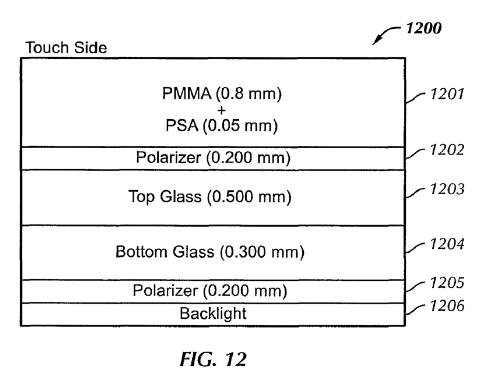
早前已經有報導,說蘋果的下一代 iPhone 會有更輕薄的螢幕。但那個時候口說無憑,這次總算是看到了蘋果獲得的新專利,在這個時間點上,不偏不巧讓人難免浮想聯翩。這是一種 in-cell 觸控螢幕,和 on-cell 技術有所不同,後者是通過將 LCD 液晶螢幕和觸控感應元件逐層疊加而成的。而蘋果是將兩者直接實現電極共用,觸控元件和顯示元件的電極整合到每個畫素中。如果通俗一點理解的話,原來觸控板和面板是兩個分離的層片,現在合併為一層,可以實現更薄的螢幕。當然僅追求薄是不夠的,它還能節約成本,同時減少了螢幕疊加的層數,在製造工藝上就更簡便從而提升生產效率。從專利上來看,這應該非常適合於蘋果的智慧手機,但是在新一代 iPhone 正式發佈之前,我們還不能確認它就一定會出現在新機子上。考慮到這項專利在 2007 年 6 月份的時候就已經提交,那時候第一代 iPhone 還沒有上市,所以蘋果有足夠的時間來打磨這項技術。我們會在新的 iPhone 上看到這種 in-cell 螢幕麼?就讓 Tim Cook 來告訴我們答案吧。


Apple on Tuesday received a patent for touch screen LCD technology which integrates touch-sensing elements with display circuitry to create a thinner, lighter panel that will possibly make its way to the company's popular smartphone.
Apple's U.S. Patent No. 8,243,027 for a "Touch screen liquid crystal display" describes a variety of methods in which a touchscreen's touch-sensing elements are integrated within the LCD, unlike current technology which places the touch layer over a device's screen. The patent filing cross-references a number of properties regarding multi-touch and LCD technologies.
LCD touchscreen technology used in the current iPhone 4S, for example, is "glass-on-glass" or "on cell," meaning the touch sensitive capacitive element is sandwiched between a display unit's top glass and a protective Gorilla Glass layer. Below the LCD's top glass is the liquid crystal array, a bottom glass and backlight assembly.
In a traditional configuration, colors and brightness are achieved through use of thin film transistors (TFT) overlaid on the top or bottom mother-glasses. The transistors apply a charge to the liquid crystals, which are held in cells, changing their orientation and allowing backlight transmission for the desired pixel color or brightness.
In-cell technology removes the top substrate, or glass layer, by combining the liquid crystal and touch sensing elements into a single structure. As seen in the patent filing, there are multiple ways of integrating the elements.
From the patent filing:
By integrating the layered structure of an LCD and a touch sensor, a variety of benefits can be achieved. This integration can include combining or interleaving the layered structures described above. Integration can further include eliminating redundant structures and/or finding dual purposes (e.g., one purpose for the touch function and another for the display function) for particular layers or structures. This can permit some layers to be eliminated, which can reduce cost and thickness of the touch screen LCD, as well as simplify manufacturing.
One of the methods described is of particular interest to Apple as it can be implemented in both conventional and in-plane-switching (IPS) panels, the latter being used in the current iPhone 4S' Retina display and a number of other products from the Cupertino company.
In one of Apple's patent concepts regarding an in-cell IPS panel, the technology can "provide touch-sensing capabilities by allowing the same electrodes used for display updating to also be used for touch sensing." This sharing of electrodes is necessary as IPS displays lack the requisite layer to apply a touch drive or touch sensing elements. The patent goes on to say the additional circuitry can help augment the shared electrodes and in some cases "touch pixels can overlap a large number of display pixels."
From the patent filing:
In contrast, because the IPS embodiments discussed below can use the same electrodes used for display control and touch sensing, higher touch resolution can be obtained with little to no additional cost. Alternatively, a number of touch pixels can be grouped to produce a combined touch signal with a lower resolution.
Rumors swirled in April that Apple was looking to employ so-called "in-cell" touchscreen technology into a next-generation iPhone, allowing the company to keep weight and size down as the handset moves from a 3.5-inch screen to a larger 4-inch version. The Wall Street Journal in July corroborated the early reports. Display manufacturers like Sharp and LG are at the cutting edge of in-cell technology are have purportedly been tapped to supply the new iPhone's screens.
Tuesday's patent filing describes a display similar to the rumored in-cell units, but includes a variety of ways to integrate a touch sensitive element into an LCD array, not just one. Also outlined are processes related to manufacturing the new screens, whether it be by modifying existing methods or creating entirely new steps in the manufacturing process flow.



 留言列表
留言列表